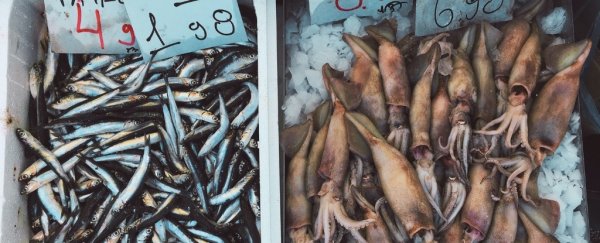Plastics were not made for human consumption, and yet consume them we must. Tiny remnants of these synthetic polymers have now leached into our air, food and water, and avoiding them has turned into an almost impossible battle.
A study of five popular seafoods, bought from a market in Australia, reveals just how ubiquitous these micro pollutants have become.
After buying five wild blue crabs, ten farmed tiger prawns, ten wild squid, ten farmed oysters, and ten wild sardines, researchers found traces of plastic in every single sample.
"Considering an average serving, a seafood eater could be exposed to approximately 0.7 milligrams of plastic when ingesting an average serving of oysters or squid, and up to 30 mg of plastic when eating sardines, respectively," explains Francisca Ribeiro, who studies dietary exposure to plastics at the University of Queensland, Australia.
"For comparison, 30 milligrams is the average weight of a grain of rice."
We still don't know what, if anything, this is doing to our bodies, but there's reason to find out.
The ocean is the ultimate sink for plastics in the world, and understanding the extent the marine food web is contaminated with these pollutants is part of the challenge.
After ingesting plastics of our own making, many marine species have been found struggling with physical damage and oxidative stress. Some have even died, like the beached whales we've found stuffed with garbage.
The risks for land mammals are not known, and while we're probably not swallowing nearly as much plastic as these whales, we need to know how much we actually are consuming to know if we're in danger.
"Our findings show that the amount of plastics present varies greatly among species, and differs between individuals of the same species," says Ribeiro.
Using a novel mass spectrometry technique that simultaneously scans for five different kinds of popular plastic, researchers found samples of squid from the Australian market contained the fewest traces, while sardines held the most.
Polyethylene, which is a plastic used in films and laminates, was found in the highest concentration, whereas polyvinyl chloride, aka PVC, was the most ubiquitous, found in every single sample.
This isn't out of line with what other recent studies have discovered. While it's not just seafood that contains microplastics (sugars, salts, alcohol, and water contain them too), research has shown this category of food does account most of our plastic intake.
In places where seafood is consumed heavily, studies suggest some people swallow at least 11,000 microplastic particles a year.
The trouble is, so many of these studies employ different methodologies and report results in different ways. Plus, many don't identify individual types of plastic and rely on visual observations alone.
Having a universal way to carefully test tissue samples for various kinds of plastics will allow scientists to compare results from around the world far more easily. This new technique looks like a promising avenue, allowing scientists to hone in on even tinier amounts of plastic with greater accuracy than before.
"We do not fully understand the risks to human health of ingesting plastic," says marine scientist Tamara Galloway from the University of Exeter, "but this new method will make it easier for us to find out."
If only it was harder to find seafood to test it on.
The study was published in Environmental Science & Technology.
